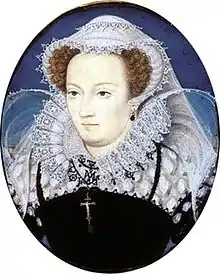Throckmorton Plot
The 1583 Throckmorton Plot was one of a series of attempts by English Roman Catholics to depose Elizabeth I of England and replace her with Mary, Queen of Scots, then held under house arrest in England.[1]
The plot is named after the key conspirator, Sir Francis Throckmorton, cousin of Bess Throckmorton, lady in waiting to Queen Elizabeth. Francis was arrested in November 1583 and executed in July 1584.
Objectives
The plot aimed to free Mary, Queen of Scots, under house arrest in England since 1568, make her queen in place of Elizabeth and legally restore Roman Catholicism. That would be achieved by a Spanish-backed invasion of England, led by the French Duke of Guise, supported by a simultaneous revolt of English Roman Catholics. Guise would marry Mary and become king.
Guise was head of the Catholic League, a key participant in the French Wars of Religion. As one of those who planned the 1572 Bartholomew's Day massacre, he was loathed by Protestants throughout Europe and perhaps the least likely candidate for such an undertaking.[2]
It was typical of the amateurish and overly optimistic approach of many such attempts; Throckmorton was placed under surveillance almost as soon as he returned to England, and the plot never put into action.[3]
Events

Francis Throckmorton (1554-1584) came from a prominent English Catholic family, his father John Throckmorton being a senior judge and witness to Queen Mary's will. While travelling in Europe with his brother Thomas from 1580 to 1583, they visited Paris and met with Catholic exiles Charles Paget and Thomas Morgan.
After returning to London in 1583, Francis carried messages between Mary, Morgan and Bernardino de Mendoza, Philip II of Spain's ambassador in London. Correspondence was routed through the French embassy in London and an agent within the embassy notified Francis Walsingham, Elizabeth's Secretary of State. Throckmorton was taken into custody in November, along with incriminating documents, including lists of English Catholic supporters.[4]
Shortly before his arrest, Francis managed to send a casket of other documents to Mendoza; it has been suggested this was exactly what Walsingham wanted him to do. Francis was a relatively minor player, whose significance was to confirming the extent of Spanish involvement in seeking to overthrow Elizabeth.[5]
Protected by diplomatic immunity, Mendoza was expelled in January 1584; he was the last Spanish ambassador to England during the Elizabethan era. After being tortured to ensure he had revealed as much information as possible, Throckmorton was executed in July 1584. His brother Thomas and many others managed to escape; some were imprisoned in the Tower of London but Francis was the only one executed.[3][6]
Aftermath
Mary was placed under strict confinement at Chartley Hall in Staffordshire, while Walsingham and Lord Burghley drew up the Bond of Association, obliging all signatories to execute anyone who attempted to usurp the throne or to assassinate the Queen. Mary herself was one of the signatories and it provided the basis for her execution following the 1586 Babington Plot.[7]
Many participants in the Babington and Gunpowder Plots were related by blood or marriage to Francis, among them Robert Catesby and Francis Tresham. Bess Throckmorton (1565-1647) secretly married Sir Walter Raleigh (1554-1618).
References
- The Watchers: A Secret History of the Reign of Elizabeth I: Stephen Alford
- Stuart Carroll, Martyrs and Murderers:The Guise Family and the Making of Europe, (Oxford University Press, 2011), 187.
- Wagner, John A. (1999). Historical dictionary of the Elizabethan world : Britain, Ireland, Europe, and America. Chicago, Ill. [u.a.]: Fitzroy Dearborn Publ. pp. 302–3. ISBN 1-57958--269--9.
- Budiansky, Stephen. "Sir Francis Walsingham". Britannica.com. Retrieved 6 July 2019.
- Plowden, Alison (2015). Throckmorton [Throgmorton], Francis. Oxford DNB. doi:10.1093/ref:odnb/27390.
- Wagner, John A.; Schmid, Susan Walters (2012). Encyclopedia of Tudor England. Santa Barbara, Calif.: ABC-CLIO. ISBN 978-1-59884-299-9.
- Heisch, Allison (1994). "Arguments for an Execution: Queen Elizabeth's 'White Paper' and Lord Burghley's 'Blue Pencil". Albion: A Quarterly Journal Concerned with British Studies. 24 (4): 592–593. doi:10.2307/4050668. JSTOR 4050668.
Sources
- O'Day, Rosemary (1995). The Tudor Age. England: Longman Group Limited.
- Warren, John (2002). Elizabeth I: Religion and Foreign Affairs. Singapore: Hodder Murray.
- Lotherington, John (ed.) (1994). The Tudor Years. Hodder and Stoughton. ISBN 0-340-53794-9.CS1 maint: extra text: authors list (link)
- Butler, Charles (1822). "The Treason of Francis Throckmorton". Historical Memoirs of the English, Irish, and Scottish Catholics, Since the Reformation. pp. 376–377. OCLC 588795283.
- Wagner and Schmid, John A and Susan Valters (2012). Encyclopedia of Tudor England, Volume 1. Santa Barbara, CA: ABC-CLIO, LLC.
- Wagner, John A (1999). Historical Dictionary of the Elizabethan World: Britain, Ireland, Europe, and America. New York: The Onyx Press.
